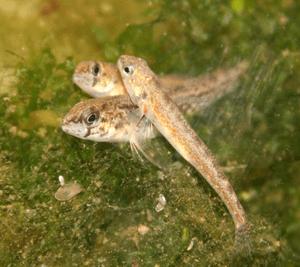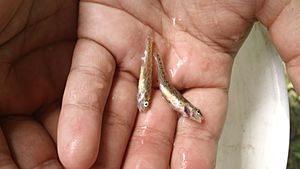Iowa darter facts for kids
Quick facts for kids Iowa darter |
|
|---|---|
 |
|
| Conservation status | |
| Scientific classification | |
| Synonyms | |
|
The Etheostoma exile, also known as the Iowa darter, is a small, colorful freshwater fish. It's a type of darter, which is part of the perch family. This family also includes well-known fish like perches and pikeperches.
Iowa darters are native to lakes and streams, especially in Iowa and other parts of North America. They are known for their quick, darting movements. Sometimes, people call them the weed darter, red-sided darter, or yellowbelly. Iowa darters are usually about 2-3 inches (5-7.5 cm) long.
Contents
Where Do Iowa Darters Live?
Iowa darters live in many places across North America. You can find them from central Canada down to central Illinois. They are very common in the western Great Lakes area and in Iowa.
Some groups of these fish are also found in Colorado, Wyoming, Montana, and Alberta. In Colorado, they live in the South Platte River and have also been found in the Yampa River and Green River.
What Does the Iowa Darter Look Like?
The Iowa darter has a very slim, small body. Most are about 5.5 cm (2.2 inches) long and live for about three years. It has a small mouth and snout. Its cheeks and gill covers are covered in scales.
This fish has two dorsal fins (fins on its back). One is spiny, and the other is soft. Its caudal fin (tail fin) is squarish. The pectoral fins and pelvic fins are close together, right behind its gills. It also has an anal fin with one or two spines. The lateral line (a sensory organ) on its side is not complete.
Male and female Iowa darters have different colors, especially during breeding season.
- Males are olive-green on top with darker spots. Their sides are red with blue rectangular patches. Their bellies are whitish, and they have a dark wedge shape below their eyes. The spiny dorsal fin has blue spots and three bands: orange, clear, and then blue.
- Females are olive-brown on top with darker spots. Their sides are mottled (patchy) and fade to silver-white on their bellies. They also have a clear dark wedge shape below their eyes.
Habitat and Habits
Iowa darters like cool, clear water with a sandy or leafy bottom. They do not have a swim bladder (a gas-filled organ that helps fish float). Because of this, they sink to the bottom of streams or lakes.
To move around, they make short, incredibly fast dashes. This is why they are called "darters"! They can zip along the bottom, looking for food, using less energy than other fish that would have to work to stay down.
What Do Iowa Darters Eat?
The Iowa darter eats tiny creatures it finds in underwater plants. These include copepods (small crustaceans), water fleas, and the larvae (young forms) of midges and mayflys. They are very quick, so they are rarely caught by other fish that eat fish.
Conservation Status
Iowa darters are considered vulnerable, meaning their numbers and where they live are decreasing. Their habitats seem to be the main problem. This might be because the water is becoming more cloudy, which limits the clear water they prefer.
Reproduction
Iowa darters mainly spawn (lay eggs) in the spring. They move from deeper parts of lakes and streams to shallow areas with lots of plants to lay their eggs.
Males usually arrive before females. They find and protect small areas near banks with plants. Smaller males don't defend territories; they just move around looking for females.
When a female enters a male's territory, the male swims around her. She then positions herself near algae or plants. The male gets on top of the female, placing his fins in certain ways. They usually lay three to seven eggs at a time.
Most eggs are laid about 10–40 cm (4–16 inches) deep on plant roots under banks. Some eggs are also laid directly on sand or on other plant materials. After spawning, the male indirectly protects the eggs by continuing to guard his territory. Females mate with several males, then return to deeper waters.
Life cycle
The eggs of the Iowa darter are about 1.1 mm (0.04 inches) wide. They take about 18–26 days to hatch at temperatures between 13-16 °C (55-61 °F). Newly hatched darters are about 3.4 mm (0.13 inches) long.
Most of their main body parts, like their fins and gill structures, form when the larvae (young fish) are between 7.7 and 9.1 mm (0.3-0.36 inches) long. Much of their lateral line sensory system develops when they reach about 20 mm (0.79 inches).
Etymology
The genus name, Etheostoma, comes from Greek words meaning "strain" or "filter" and "mouth." The species name, exile, also from Greek, means "slim" or "slender."
See also
 In Spanish: Etheostoma exile para niños
In Spanish: Etheostoma exile para niños



